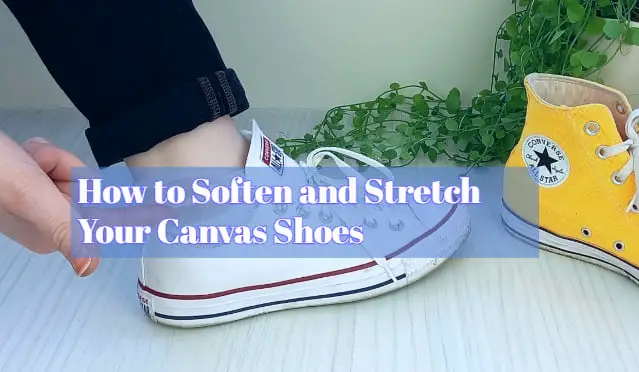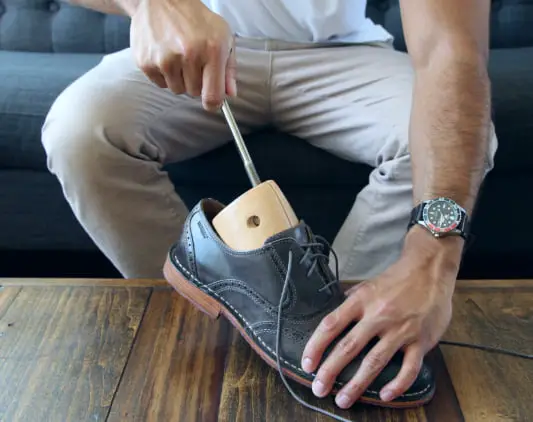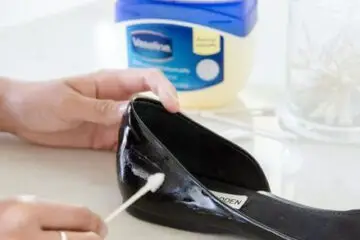Canvas shoes are a wardrobe staple. Their casual styling makes them versatile for a range of activities. Unfortunately, their stiff canvas material can cause blisters and rub your feet the wrong way. Don’t despair! With some simple tricks, you can soften and stretch canvas shoes to make them more comfortable.
Why Canvas Shoes Are Stiff
Canvas shoe uppers are typically made from cotton or cotton-blend fabrics. The fibres are woven tightly together in a dense crisscross pattern. This gives the canvas stability and structure, but also makes it stiff and unyielding. The dense weave does not easily flex and mould to your foot shape.
The vulcanized rubber outsoles are also rigid and inflexible. This solid structure benefits the durability and longevity of canvas sneakers. But it does mean breaking them in requires some extra effort.
New unworn canvas shoes need to be softened and stretched to match the unique contours of your feet. Don’t worry – with the right techniques, you can customize the fit and turn them into your most comfortable pair.

9 Clever Ways to Soften and Stretch Canvas Shoes
Here are 9 easy DIY methods to soften the canvas, stretch the shape, and customize the fit of your canvas footwear:
1. Apply Heat to the Shoes
One of the quickest ways to soften and loosen up canvas shoes is by applying heat. The warmth causes the fibres to become more pliable and flexible.
You have a couple of options when using heat:
- Use a hairdryer – Target the heat from a hairdryer on the stiffest spots for 1-2 minutes at a time. Concentrate on the toe box, sides, and anywhere the canvas rubs.
- Try a hot towel – Dampen a towel with hot water. Wrap it around the shoe and let the wet heat penetrate the fabric. Re-heat as needed.
- Use the dryer – Pop your shoes in the dryer on air fluff mode. Run it for 5-10 minutes until warmed through. Check them frequently to avoid overheating.
The heat relaxes the canvas fibres so they more readily stretch and mould to your feet. Just be cautious not to hold heat on any one spot too long to avoid damaging the materials.
2. Stuff Shoes with Newspaper or Towels

Here’s an easy overnight fix that lets your shoes subtly stretch on their own timeline.
Start by balling up sheets of newspaper or paper towels. Pack them tightly into the toe box and along the sides or tongue.
Leave the newspapers or towels stuffed inside at least overnight, or up to 48 hours for maximum effect.
As the shoe sits filled, the pressure gently pushes the canvas fibres apart bit by bit. This painlessly eases and expands the fit in a gradual way.
3. Use a Shoe Stretcher

Shoe stretchers and wideners are specially designed devices that mechanically stretch your shoes. They gently apply outward pressure to the inside walls to expand the overall shape and width.
You’ll find a range of shoe stretcher types, from toe box-only to full-foot stretchers. For canvas shoes, choose an adjustable model that lets you target and control stretch zones.
To use a shoe stretcher:
- Fully loosen the laces and open the tongue.
- Insert stretcher and tighten knob until firm (not overly tight).
- Leave in 8-12 hours until canvas relaxes into expanded shape.
- Remove the stretcher and enjoy the roomier fit!
This method is ideal if you need to size up a half or full size, or create space in narrow toe areas. Stretching gradually over hours ensures the canvas adapts without damage.
4. Apply Moisture to Soften the Canvas
You can mimic the effects of a hot towel or heat by adding moisture instead. Water acts as a mild softening agent to make stiff canvas temporarily more pliable.
Run shoes under warm sink water for 2-3 minutes while gently massaging the canvas. Focus on stubborn spots that need extra stretching.
You can also lightly spritz shoes with a spray bottle and let air dry. As moisture penetrates the cotton fabric, it swells the fibres apart for added give.
5. Soften Canvas Shoes with Olive Oil
Natural oils like olive and coconut oil gently permeate, condition, and soften canvas fibres.
Rub a quarter-sized amount into the outside of your shoes using circular motions. The oil’s emollient properties transfer moisture and flexibility into the cotton canvas weave.
Leave the shoes overnight so the oil can fully penetrate. Wipe away excess in the morning and enjoy supple canvas uppers that better mould to your feet.
6. Loosen Laces and Wear Loosely
One of the simplest softening tricks is also the easiest. Wearing your new canvas shoes with the laces as loose as possible reduces pressure on stiff spots.
This allows your foot freedom to flex and fully break-in problem zones like the toe box. As you move around, the extra wiggle room lets your foot naturally mould the shape.
Gradually begin tightening laces over time as problem zones get softer. But never cinch laces too tight, which counteracts stretching efforts.
7. Soften Tough Leather Details with Vaseline
If your canvas sneakers have suede or leather overlays, these areas need special treatment since canvas conditioning tricks won’t work.
Use a pea-sized amount of Vaseline on small leather zones like collars, eyelits, and logos. Carefully rub in to soften and condition the material.
For larger leather panels like side stripes, apply a leather conditioner instead. Massage it into the stiff spots until absorbed.
The emollients in these petroleum-jelly based products penetrate to soften tough leather. But avoid getting them on the cotton canvas, as this can leave greasy residue.
8. Break in New Canvas Sneakers at Home First
Don’t make the mistake of taking brand new stiff canvas shoes straight out of the box and into the real world. Ouch!
Plan to spend a few days breaking them in at home on your own terms before wearing them out. This helps avoid painful blisters and hot spots from overly stiff shoes.
Wear them around the house to do chores or while relaxing. The indoor use lets you control the duration of wear and build up the break-in process.
You’ll get to know exactly where the rub points are occurring. And you can use the downtime to apply stretching tricks to customize the fit. After a few days of this, your shoes will be primed for pavement pounding.
9. Wear Shoes with Thick Socks
Here’s another rookie mistake – attempting to break in stiff canvas shoes while barefoot or with thin socks. Not wise!
The stiff cotton fibres will rub and chafe your bare skin raw. Blisters will erupt before you know it.
Instead, always wear fresh clean thick socks when breaking in new canvas shoes. The extra cushioning acts like a buffer to protect your feet from abrasion against problem zones.
Thick sock padding also helps gently stretch and widen the shape from within. Focus on areas like the toe box that need extra expansion.
The sock cushioning reduces friction while allowing your feet to fully flex and mould the canvas exterior. With each step, you’ll gain flexibility and customize the ideal fit.
How Long Does It Take to Break In Canvas Shoes?
The time needed to fully break in and soften a pair of stiff new canvas shoes varies based on the techniques used.
If you utilize a heat method, you may notice an almost instant loosening effect. But the flexibility gains will be temporary and limited.
Other DIY tricks like oiling or stuffing shoes can show noticeable results overnight or after a single 8-12 hour application.
To fully customize the shape and stretch problem zones for permanent flexible softening, expect the process to take 3-5 days of consistent wear.
This gives the canvas fibres adequate time to adapt without over-stressing them. With some diligence and creative TLC, you’ll soon have custom-fit shoes moulded to your feet.
How to Stop Canvas Shoes from Rubbing the Back of Your Heels
The number one spot for painful abrasion in canvas shoes is the heel, specifically the collar lining around the Achilles tendon.
That stiff strip of canvas digs in and aggravates this thin-skinned area with every step. Luckily, you can curb collar-chewing using these tips:
- Loosen laces maximumly so the collar has room to dip with heel movement.
- Wrap small bandages or soft moleskin around rubbed areas for cushioning.
- Apply petroleum jelly to heels pre-wear for lubrication.
- Wear higher crew socks that protect the Achilles zone from direct contact.
- Stuff socks or cloth inside the heel when not wearing to stretch collar width.
- Use a shoe stretcher to expand collar circumference if needed.
Targeting the heel lining and Achilles notch for softening is key to preventing painful blisters. With some TLC, you’ll have comfortable heels in those canvas kicks in no time.
Will Canvas Shoes Stretch with Wear Over Time?
Yes, canvas shoes will conform to your foot shape and gain flexibility with consistent wear over time.
With each step, your foot stretches the upper material microscopically as you walk. Do this for days on end, and the compounding effect is noticeable softening.
Natural oils from your skin also transfer into the cotton fibres, acting as an ongoing softening agent. Pressure and friction from regular wear helps ease the structure.
But relying solely on “wearing them in” with no other tricks can mean days or weeks of discomfort until they properly adapt. This can damage your feet with blisters and calluses in the interim.
Combining proactive stretching techniques along with routine wear will expedite the custom break-in process. Meet your shoes halfway with some TLC, and they’ll soon treat your feet right.
Conclusion
From stuffing with paper to heating in the oven, this guide covered a variety of clever DIY methods for stretching and softening tight canvas shoes quickly. Finding the right techniques can mean the difference between blister agony and comfortable bliss.
While canvas shoes mould to your feet over time, employing tricks like moist heat and oil allows you to speed up the break-in process. Targeting snug areas with a stretcher, loosened laces, or padded tape protects delicate feet until the material gives
Frequently Asked Questions
How can I stretch my canvas shoes quickly?
For fast stretching, use heat from a hairdryer or towel soaked in hot water. The warmth softens fibers so shoes expand more readily. Also, loosen laces fully to allow maximum stretching as you wear them.
What household items can I stuff in my shoes to stretch them?
Crumpled newspapers, paper towels, or clean rags work well for DIY shoe stretching. Pack tightly into the toe box and along the sides. Leave stuffed for 8-12 hours so outward pressure subtly stretches the material.
Can I put canvas shoes in the dryer to soften them?
Yes, you can place canvas shoes in the dryer on a no-heat setting to soften them with the motion. Check frequently and limit drying to 5-10 minutes to avoid potential damage from over-tumbling. The heat from air fluff can be helpful too.
Should I wear thick or thin socks when breaking in canvas shoes?
Always opt for thick cushioned socks rather than thin ones. The padding acts as a buffer against stiff canvas rubbing your feet. It reduces friction while also letting your foot stretch the shape effectively from within.
How can I stop canvas shoe heels from rubbing my Achilles tendon?
Target the heel collar area by loosening laces to allow more flex room. Cushion with soft bandages or moleskin. Lubricate with petroleum jelly pre-wear. Wear higher crew socks covering your Achilles zone. Stuff the heels when not wearing to widen.
How long does it take to fully break in and soften canvas shoes?
Expect the process to take 3-5 days of consistent wear using stretching tricks like heat, oils, shoe stuffing, and sock padding. This gradual approach lets the canvas fibres adapt without over-stressing. Soon you’ll have custom-fit flexibility!
Why do my canvas shoes rub my heels raw?
Canvas shoes can rub heels raw if the material is stiff and unyielding. New shoes need breaking in to soften and prevent blisters. Make sure to size properly with enough room in the heel collar. Adding cushioning pads can also help reduce friction.
How can I stop new shoes from rubbing my pinky toe?
To prevent new shoes from blistering your pinky toe, tape or bandage hot spots, lubricate with petroleum jelly, wear two pairs of socks, and stretch the toe box area with a shoe stretcher or heat. Shoes may need a cobbler to stretch the width for problem feet.
Why do my heels keep slipping in canvas shoes?
Heels can slip in canvas shoes if sized too big, laced too loosely, or lacking traction on the heel counter. Try sizing down, adjust the lacing technique, add heel grips, or apply no-slip heel inserts to stabilize the fit. Wider feet may need to tighten shoelaces more or opt for high-top styles.
How can I soften the heal of stiff canvas shoes?
To soften stiff canvas shoe heels, use a heel stretcher tool overnight, heat the area with a hairdryer, liberally apply moisturizers like olive oil or Vaseline, pad with cushy heel cups, and wear the shoes with two pairs of socks to protect from rubbing. Shoe stretch sprays can also target just the heel area.



